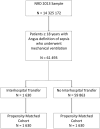Outcomes of Ventilated Patients With Sepsis Who Undergo Interhospital Transfer: A Nationwide Linked Analysis
- PMID: 29068858
- PMCID: PMC5734994
- DOI: 10.1097/CCM.0000000000002777
Outcomes of Ventilated Patients With Sepsis Who Undergo Interhospital Transfer: A Nationwide Linked Analysis
Abstract
Objectives: The outcomes of critically ill patients who undergo interhospital transfer are not well understood. Physicians assume that patients who undergo interhospital transfer will receive more advanced care that may translate into decreased morbidity or mortality relative to a similar patient who is not transferred. However, there is little empirical evidence to support this assumption. We examined country-level U.S. data from the Nationwide Readmissions Database to examine whether, in mechanically ventilated patients with sepsis, interhospital transfer is associated with a mortality benefit.
Design: Retrospective data analysis using complex survey design regression methods with propensity score matching.
Setting: The Nationwide Readmissions Database contains information about hospital admissions from 22 States, accounting for roughly half of U.S. hospitalizations; the database contains linkage numbers so that admissions and transfers for the same patient can be linked across 1 year of follow-up.
Patients: From the 2013 Nationwide Readmission Database Sample, 14,325,172 hospital admissions were analyzed. There were 61,493 patients with sepsis and on mechanical ventilation. Of these, 1,630 patients (2.7%) were transferred during their hospitalization. A propensity-matched cohort of 1,630 patients who did not undergo interhospital transfer was identified.
Interventions: None.
Measurements and main results: The exposure of interest was interhospital transfer to an acute care facility. The primary outcome was hospital mortality; the secondary outcome was hospital length of stay. The propensity score included age, gender, insurance coverage, do not resuscitate status, use of renal replacement therapy, presence of shock, and Elixhauser comorbidities index. After propensity matching, interhospital transfer was not associated with a difference in in-hospital mortality (12.3% interhospital transfer vs 12.7% non-interhospital transfer; p = 0.74). However, interhospital transfer was associated with a longer total hospital length of stay (12.8 d interquartile range, 7.7-21.6 for interhospital transfer vs 9.1 d interquartile range, 5.1-17.0 for non-interhospital transfer; p < 0.01).
Conclusions: Patients with sepsis requiring mechanical ventilation who underwent interhospital transfer did not have improved outcomes compared with a cohort with matched characteristics who were not transferred. The study raises questions about the risk-benefit profile of interhospital transfer as an intervention.
Conflict of interest statement
Financial Disclosures: No financial disclosures
Conflict of Interest: No authors have any conflicts of interest to disclose
The remaining authors have disclosed that they do not have any potential conflicts of interest.
Figures
Comment in
-
Limitations in Conclusions Regarding Critical Care Transport.Crit Care Med. 2018 Jul;46(7):e729-e730. doi: 10.1097/CCM.0000000000003117. Crit Care Med. 2018. PMID: 29912131 No abstract available.
-
The authors reply.Crit Care Med. 2018 Jul;46(7):e730-e731. doi: 10.1097/CCM.0000000000003178. Crit Care Med. 2018. PMID: 29912132 Free PMC article. No abstract available.
Similar articles
-
Transfer hospitalizations for pediatric severe sepsis or septic shock: resource use and outcomes.BMC Pediatr. 2019 Jun 13;19(1):196. doi: 10.1186/s12887-019-1577-5. BMC Pediatr. 2019. PMID: 31196011 Free PMC article.
-
Racial and Geographic Disparities in Interhospital ICU Transfers.Crit Care Med. 2018 Jan;46(1):e76-e80. doi: 10.1097/CCM.0000000000002776. Crit Care Med. 2018. PMID: 29068859 Free PMC article.
-
Case Volume-Outcomes Associations Among Patients With Severe Sepsis Who Underwent Interhospital Transfer.Crit Care Med. 2017 Apr;45(4):615-622. doi: 10.1097/CCM.0000000000002254. Crit Care Med. 2017. PMID: 28151758 Free PMC article.
-
Interhospital Transfer of Patients With Acute Respiratory Failure in the United States: A Scoping Review.Crit Care Explor. 2024 Jul 5;6(7):e1120. doi: 10.1097/CCE.0000000000001120. eCollection 2024 Jul 1. Crit Care Explor. 2024. PMID: 38968159 Free PMC article.
-
Interhospital transfer (IHT) in emergency general surgery patients (EGS): A scoping review.Surg Open Sci. 2022 May 21;9:69-79. doi: 10.1016/j.sopen.2022.05.004. eCollection 2022 Jul. Surg Open Sci. 2022. PMID: 35706931 Free PMC article.
Cited by
-
Risk-standardized sepsis mortality map of the United States.Digit Health. 2022 Jan 20;8:20552076211072400. doi: 10.1177/20552076211072400. eCollection 2022 Jan-Dec. Digit Health. 2022. PMID: 35096409 Free PMC article.
-
Treatment in Disproportionately Minority Hospitals Is Associated With Increased Risk of Mortality in Sepsis: A National Analysis.Crit Care Med. 2020 Jul;48(7):962-967. doi: 10.1097/CCM.0000000000004375. Crit Care Med. 2020. PMID: 32345833 Free PMC article.
-
Double inter-hospital transfer in Sepsis patients presenting to the ED does not worsen mortality compared to single inter-hospital transfer.J Crit Care. 2020 Apr;56:49-57. doi: 10.1016/j.jcrc.2019.11.018. Epub 2019 Nov 30. J Crit Care. 2020. PMID: 31837601 Free PMC article.
-
Sex Disparities in the Management, Outcomes, and Transfer of Patients Hospitalized for Cardiogenic Shock.J Soc Cardiovasc Angiogr Interv. 2023 Nov 10;3(3Part A):101212. doi: 10.1016/j.jscai.2023.101212. eCollection 2024 Mar. J Soc Cardiovasc Angiogr Interv. 2023. PMID: 39131782 Free PMC article.
-
A Standardized and Regionalized Network of Care for Cardiogenic Shock.JACC Heart Fail. 2022 Oct;10(10):768-781. doi: 10.1016/j.jchf.2022.04.004. Epub 2022 Jun 8. JACC Heart Fail. 2022. PMID: 36175063 Free PMC article.
References
-
- Iwashyna TJ. The incomplete infrastructure for interhospital patient transfer. Crit Care Med. 2012;40(8):2470–2478. - PubMed
-
- Wilcox SR, Ries M, Bouthiller TA, et al. The Importance of Ground Critical Care Transport A Case Series and Literature Review. Journal of Intensive Care Medicine. 2016 0885066616668484. - PubMed
-
- Nallamothu BK, Bradley EH. Time to treatment in primary percutaneous coronary intervention. New England Journal of Medicine. 2007 - PubMed
MeSH terms
Grants and funding
LinkOut - more resources
Full Text Sources
Other Literature Sources
Medical


